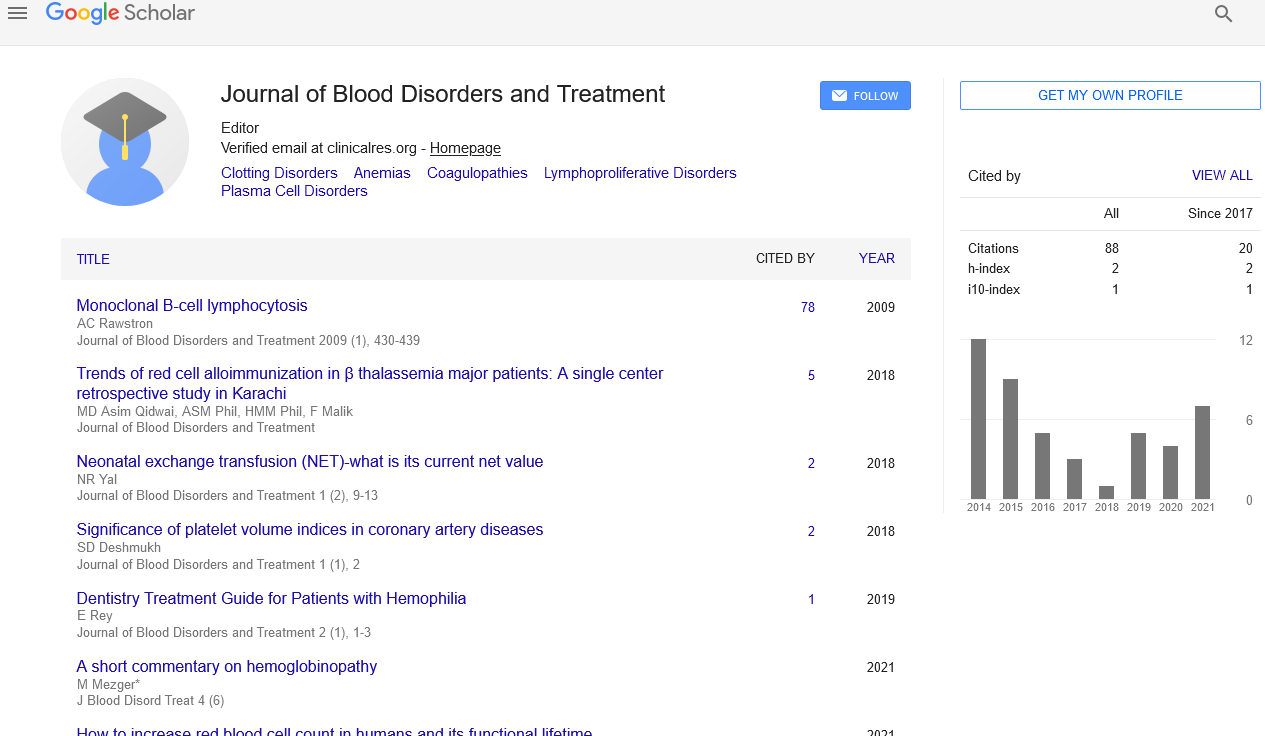Transfusions of blood
Received: 05-Jul-2022, Manuscript No. PULJBDT-22-5498; Editor assigned: 07-May-2022, Pre QC No. PULJBDT-22-5498 (PQ); Accepted Date: Jul 20, 2022; Reviewed: 14-Jul-2022 QC No. PULJBDT-22-5498 (Q); Revised: 16-Jul-2022, Manuscript No. PULJBDT-22-5498 (R); Published: 24-Jul-2022, DOI: 10.37532/puljbdt.2022.5(4).1-2
This open-access article is distributed under the terms of the Creative Commons Attribution Non-Commercial License (CC BY-NC) (http://creativecommons.org/licenses/by-nc/4.0/), which permits reuse, distribution and reproduction of the article, provided that the original work is properly cited and the reuse is restricted to noncommercial purposes. For commercial reuse, contact reprints@pulsus.com
Abstract
Transfusions of blood components, also known as blood transfusions, can benefit a patient's health. They might even help a patient survive. When compared to the advantages that blood components can offer, the number of individuals who suffer severe illness or pass away as a result of a blood component is extremely low. Red blood cells and other blood components that are missing or have low levels as a result of an injury or sickness are frequently replaced with other blood components
Key Words
Plasma; Alloantibodies; Arthropathy
INTRODUCTION
Plasma and red blood cells are both found in blood. For open heart surgery, whole blood is frequently used. It can also be used for exchange transfusions, which completely replace a newborn's blood in cases of newborn hemolytic disease. The usage of this product for other purposes is uncommon. The tissues receive oxygen thanks to red blood cells. The majority of the plasma from the entire blood has been separated from packed red blood cells. Most frequently, packed cells are infused into a vein during a two- to fourhour period. This is used to replenish the red blood cells lost as a result of bleeding, hemolysis (the breakdown of red blood cells), or when the bone marrow stops producing as many red blood cells. Cell production may be affected by bone marrow failure, malignancy of the marrow, the side effects of chemotherapy medicines, or anaemia brought on by premature birth.
Fresh frozen plasma is plasma that was taken from the blood donor, frozen, and then kept in storage. There are numerous coagulation factors in fresh frozen plasma. To supplement the low amounts of clotting factors, it is frequently used either alone or in combination with cryoprecipitate. It is typically injected over a one- to two-hour period into a vein. pieces of blood cells that aid in blood clotting. The cell fragments known as platelets are what stop or stop bleeding and bruises by sealing the blood vessel hole. Most frequently, platelets are injected into a vein over a period of minutes to hours. Most frequently, a patient needs platelet transfusions once or twice a week if their bone marrow is not producing enough of them (or even more often). When a patient's platelets are not functioning properly as a result of medications, a condition, or physical harm, platelets may also be administered.
Only specific clotting factors, such as factor VIII (which is missing in haemophilia A), von Willebrand factor, and fibrinogen are present in cryoprecipitate, a portion of blood. Nowadays, cryoprecipitate is only ever administered as a source of fibrinogen (needed for forming a clot). Cryoprecipitate may be used to treat clotting defects in patients with specific kinds of haemophilia or those lacking fibrinogen. Additionally, seriously unwell people may develop DIC, an abnormal clotting syndrome. The body's clotting factors may be reduced as a result, which could lead to serious bleeding. Cryoprecipitate can be administered in addition to freshly frozen plasma to assist replenish low levels of clotting factors. Most frequently, cryoprecipitate is injected into a vein over a period of minutes to hours.
Cells that aid in infection prevention. Neutrophils are another name for granulocytes. They are cells that aid in the defence against viral or bacterial infections. Granulocytes are occasionally administered to patients with extremely low blood levels of granulocytes who have not responded to treatment to assist them fight off serious infections. Typically, patients receive granulocytes every day for five days or until their granulocyte count reaches a point where they are able to fight the infection on their own. Most frequently, granulocytes are infused into a vein over a one- to two-hour period.
The usage of a blood component might occasionally have unfavourable effects. The majority of these responses are uncommon and are typically manageable. If a negative reaction happens, alternative approaches to the issue's solution may be used.
If a patient's immune system responds to the blood component, undesirable immune-mediated responses may happen. Additionally, it may take place if the patient's cells or fluids trigger an immunological response in the blood component. These responses are not typical.
There are more options occasionally. Depending on the status of your child, your medical team can discuss which ones might be utilised with you. These may consist of
drugs that can encourage the production of more platelets, white blood cells, and red blood cells in the bone marrow (erythropoietin, granulocyte-colony stimulating factor). More recent agents are being created. Specific clotting factors, medications that reduce the risk of bleeding in the mouth and throat (such as Amicar), or raising the level of specific coagulation factors can all be used to address bleeding issues (DDAVP). Protamine sulphate can stop bleeding if too much heparin was consumed by the body. Prior to surgery, certain surgical patients may have their own blood banked. They receive their own blood back following surgery (an autologous unit). It's possible that other patients will receive the blood that was lost during surgery.
If the blood is free of infectious agents and the donor is compatible, you can also request a specific donor to donate blood for the transfusion. Experience has demonstrated that the blood from these directed donor units is no less safe than blood from a regular volunteer blood donor. A few days following surgery, some patients can tolerate having low haemoglobin levels if they take supplemental iron to rebuild their own blood flow.





